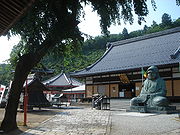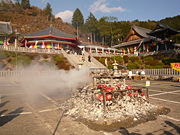.gif)
Dairyu-ji (Gifu)
Encyclopedia


Buddhist temples in Japan
Along with Shinto shrines, Buddhist temples are the most numerous, famous, and important religious buildings in Japan.The term "Shinto shrine" is used in opposition to "Buddhist temple" to mirror in English the distinction made in Japanese between Shinto and Buddhist religious structures. In...
of the Rinzai school
Rinzai school
The Rinzai school is , one of three sects of Zen in Japanese Buddhism.Rinzai is the Japanese line of the Chinese Linji school, which was founded during the Tang Dynasty by Linji Yixuan...
located in Gifu
Gifu, Gifu
is a city located in the south-central portion of Gifu Prefecture, Japan, and serves as the prefectural capital. The city has played an important role in Japan's history because of its location in the middle of the country. During the Sengoku period, various warlords, including Oda Nobunaga, used...
, Gifu Prefecture
Gifu Prefecture
is a prefecture located in the Chūbu region of central Japan. Its capital is the city of Gifu.Located in the center of Japan, it has long played an important part as the crossroads of Japan, connecting the east to the west through such routes as the Nakasendō...
, Japan
Japan
Japan is an island nation in East Asia. Located in the Pacific Ocean, it lies to the east of the Sea of Japan, China, North Korea, South Korea and Russia, stretching from the Sea of Okhotsk in the north to the East China Sea and Taiwan in the south...
. It is one of the Mino Thirty-three Kannon
Mino Thirty-three Kannon
The are a collection of Buddhist temples in southern Gifu Prefecture, Japan. The name is derived from Mino Province, the former name for the area...
. It is located near the Takatomi-chō area of Yamagata
Yamagata, Gifu
is a city located in Gifu, Japan.-History:The city was established on April 1, 2003, by merger of the towns of Miyama and Takatomi, and the village of Ijira, all from Yamagata District.-External links:*...
, so it is also sometimes referred to as Takatomi Dairyū-ji (高富大龍寺). Also, it has an annual festival at which daruma are burned, giving it another nickname, Daruma Kannon (だるま観音).
The temple has strong ties to both the Toki clan
Toki clan
The was a powerful clan that ruled in Japan from the Kamakura period to the Edo period. It descended from Emperor Seiwa by Minamoto no Yorimitsu from the Minamoto clan and used Toki in Mino Province as their hometown...
and Inaba Ittetsu.
History
Dairyū-ji was constructed as a national shrine in the Asuka periodAsuka period
The , was a period in the history of Japan lasting from 538 to 710 , although its beginning could be said to overlap with the preceding Kofun period...
during the reign of Empress Jitō
Empress Jito
was the 41st emperor of Japan, according to the traditional order of succession.Jitō's reign spanned the years from 686 through 697.In the history of Japan, Jitō was the third of eight women to take on the role of empress regnant. The two female monarchs before Jitō were Suiko and Kōgyoku/Saimei...
. During the Heian period
Heian period
The is the last division of classical Japanese history, running from 794 to 1185. The period is named after the capital city of Heian-kyō, or modern Kyōto. It is the period in Japanese history when Buddhism, Taoism and other Chinese influences were at their height...
, it came under the influence of the Shingon school
Shingon Buddhism
is one of the mainstream major schools of Japanese Buddhism and one of the few surviving Esoteric Buddhist lineages that started in the 3rd to 4th century CE that originally spread from India to China through traveling monks such as Vajrabodhi and Amoghavajra...
of Buddhism. Emperor Go-Shirakawa
Emperor Go-Shirakawa
Emperor Go-Shirakawa was the 77th emperor of Japan, according to the traditional order of succession...
enshrined a bodhisattva
Bodhisattva
In Buddhism, a bodhisattva is either an enlightened existence or an enlightenment-being or, given the variant Sanskrit spelling satva rather than sattva, "heroic-minded one for enlightenment ." The Pali term has sometimes been translated as "wisdom-being," although in modern publications, and...
in the temple.
During the Meiō
Meio
, also known as Mei-ō, was a after Entoku and before Bunki. This period spanned the years from July 1492 through February 1501. Reigning emperors were and .-Change of era:...
era, the Toki clan gained power of the area and control of the temple. In 1502, just after the Meiō era ended, the temple came under control of the Rinzai school of Zen
Zen
Zen is a school of Mahāyāna Buddhism founded by the Buddhist monk Bodhidharma. The word Zen is from the Japanese pronunciation of the Chinese word Chán , which in turn is derived from the Sanskrit word dhyāna, which can be approximately translated as "meditation" or "meditative state."Zen...
.
Daruma Memorial Service
The temple holds an annual memorial service each year for daruma whose wishes have been fulfilled. Approximately 10,000 figures are burned each year and it takes an entire day for the figures to burn. Until 2007, the festival was held every year on January 18, but the date has since been changed to the second Sunday of the year.See also
- For an explanation of terms concerning Japanese Buddhism, Japanese Buddhist art, and Japanese Buddhist temple architecture, see the Glossary of Japanese BuddhismGlossary of Japanese BuddhismThis is the glossary of Japanese Buddhism, including major terms the casual reader might find useful in understanding articles on the subject. Words followed by an asterisk are illustrated by an image in one of the photo galleries...
.

